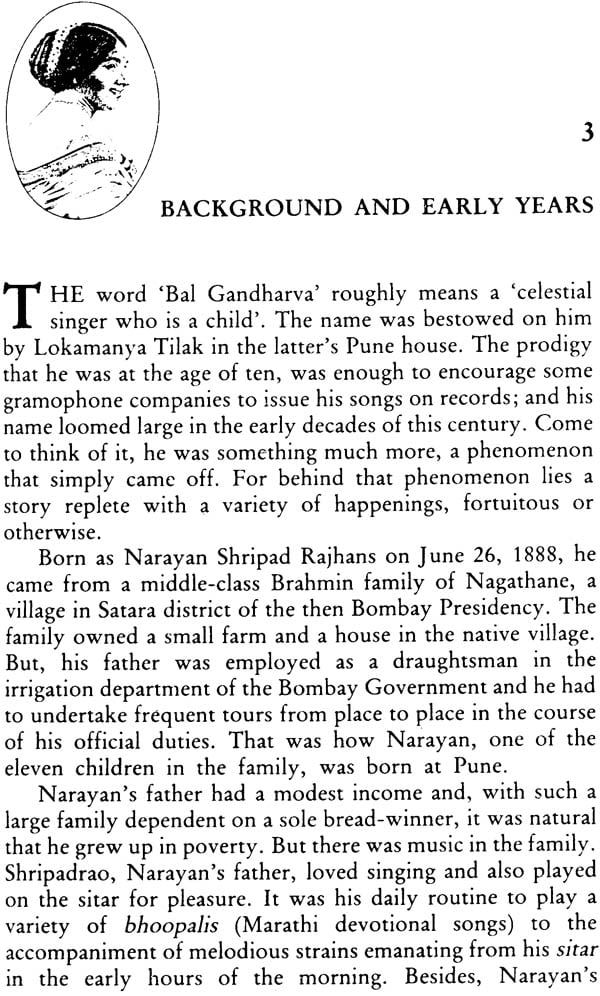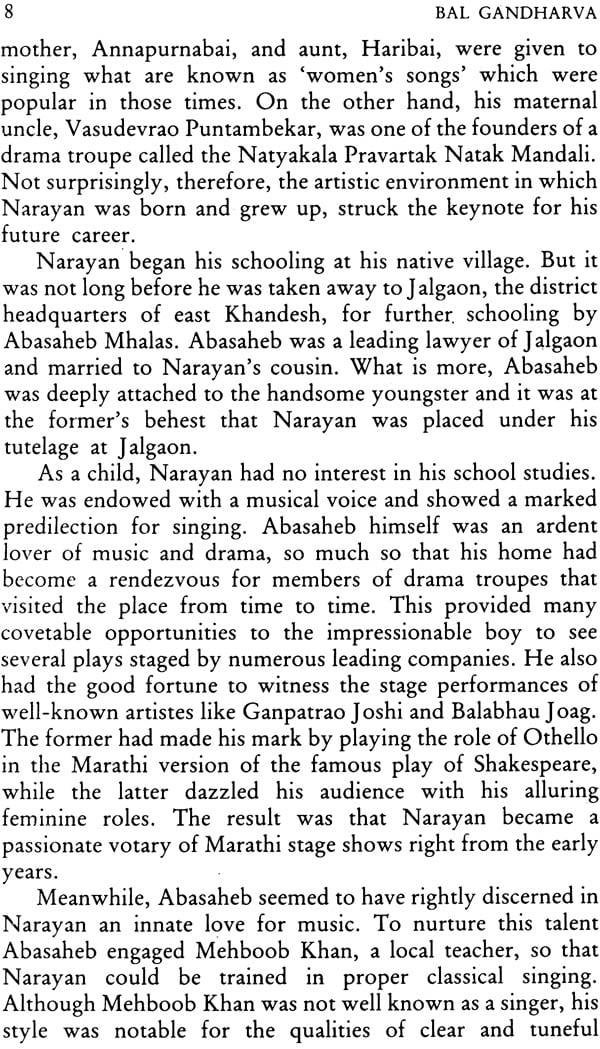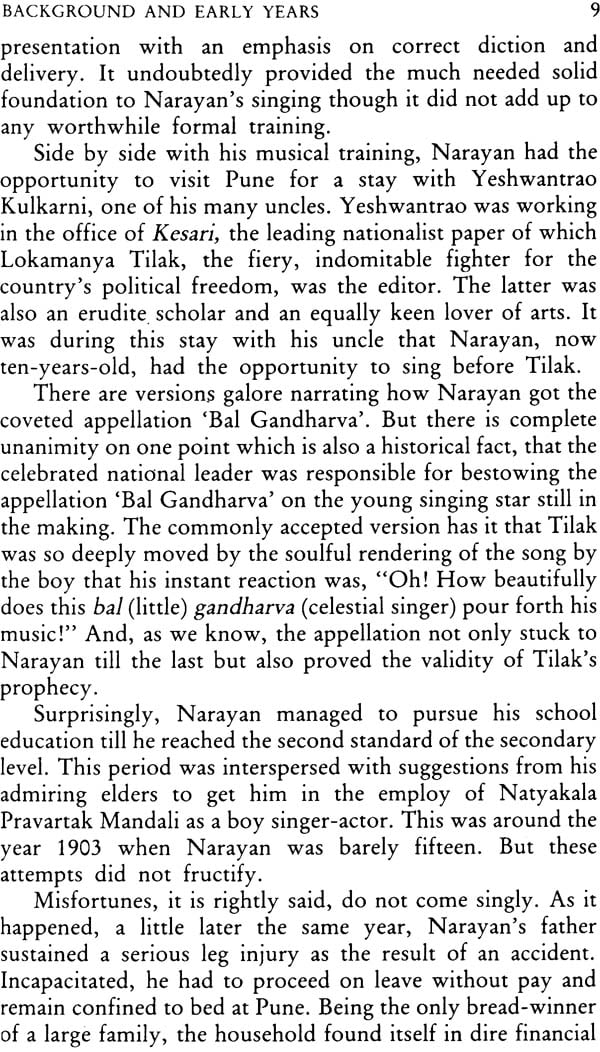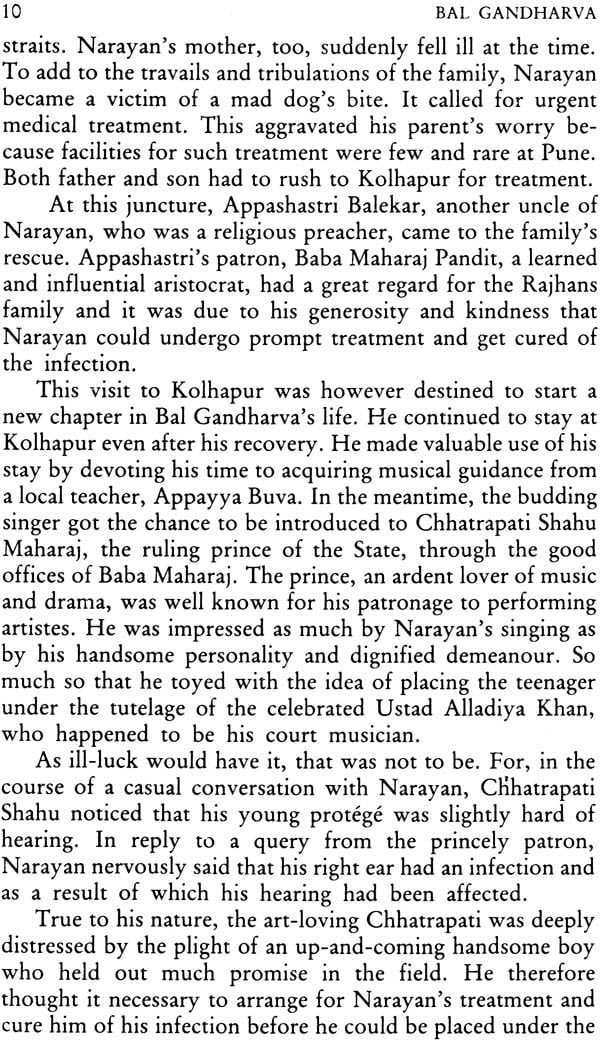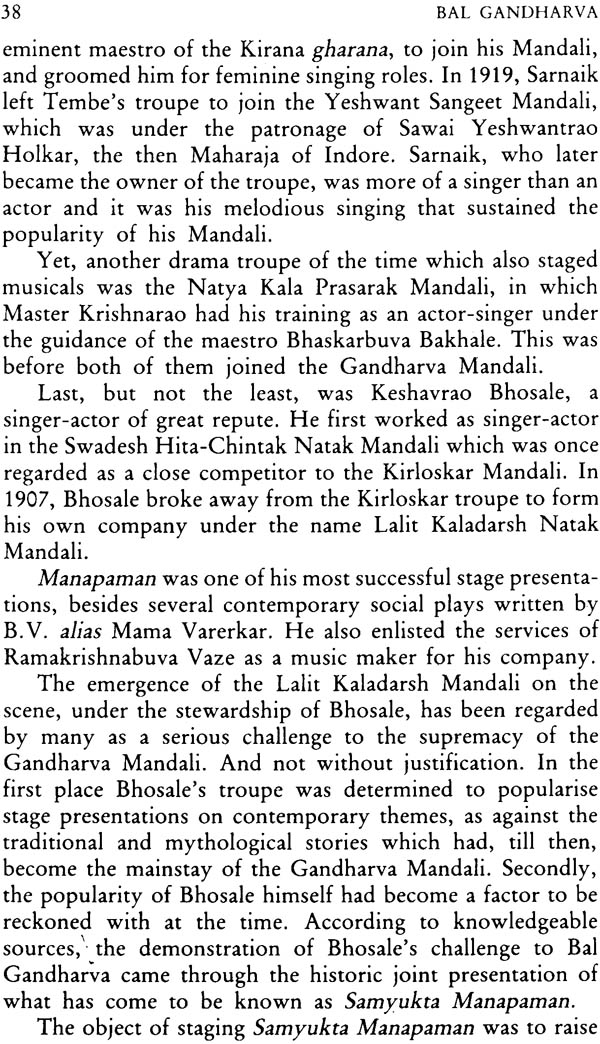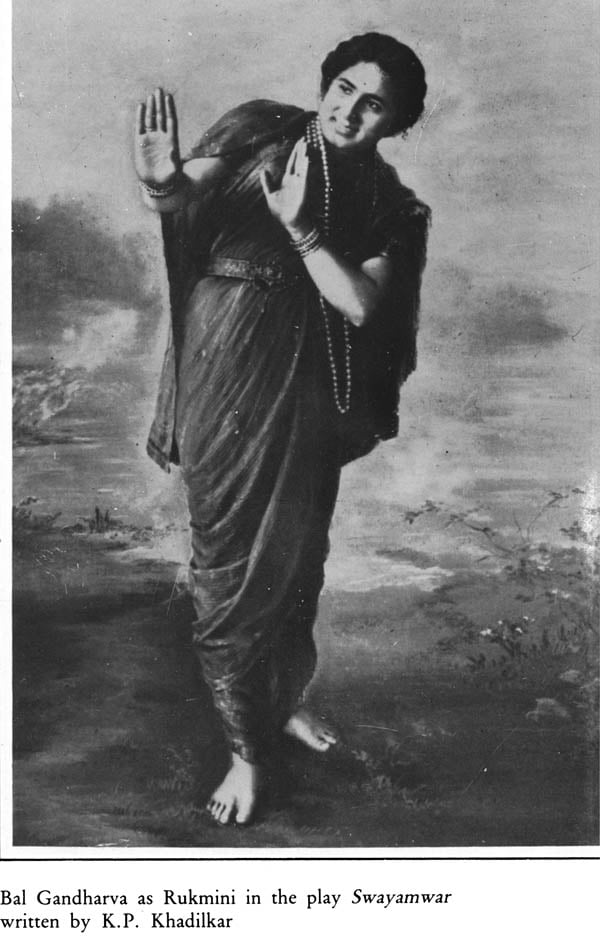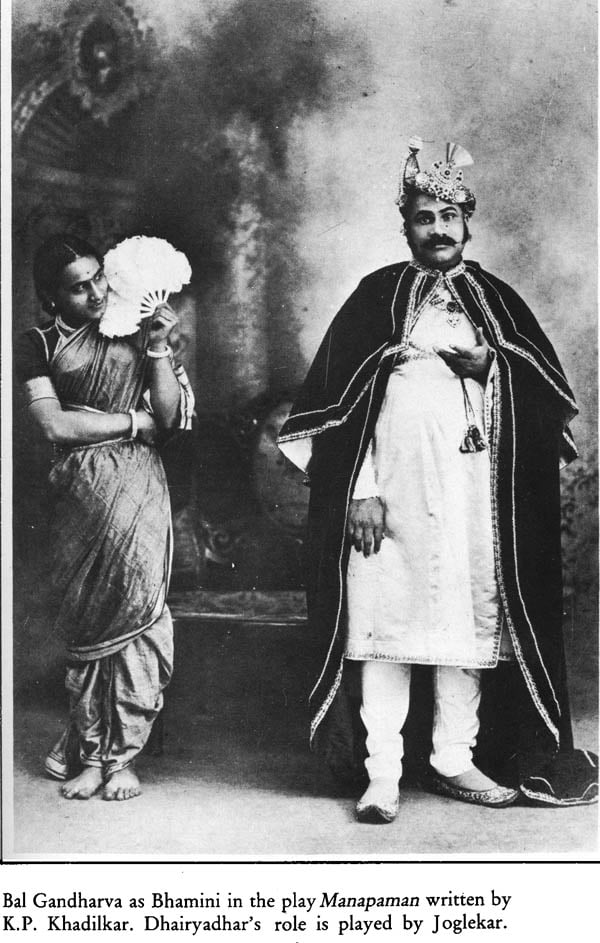
BAL GANDHARVA (The Nonpareil Thespain)
Book Specification
| Item Code: | IDD719 |
| Author: | Mohan Nadkarni |
| Publisher: | National Book Trust, India |
| Language: | English |
| Edition: | 2014 |
| ISBN: | 9788123737133 |
| Pages: | 80 (B & W Illus: 6) |
| Cover: | Paperback |
| Other Details | 8.5" X 5.5" |
| Weight | 130 gm |
Book Description
Bal Gandharva (1888-1967), who reigned supreme in the world of the Marathi musical drama for almost half a century, was born as Narayan Shripad Rajhans in a middle-class Brahmin family. Endowed with a melodious voice and handsome looks, Bal Gandharva joined the Kirloskar Natak Mandali at the age of 17 to sing and play the female role in the Marthi version of the old Sanskrit classic, Shakuntal. In Mandali, and staged a wide variety of plays which included the old classics and the new contemporary themes. With advancing age, he took to giving extempore recitals of devotional and popular stage songs. Official recognition came to this unanimously acclaimed 'Nat samrat' after 1944, when he was elected president of the Marathi Natya Shatabadi Sammelan. In 1955 he was given the Central Sangeet Natak Akademi award and in 1964 he was awarded the Padma Bushan. Incapacitated by paralysis since 1952, this uncrowned monarch of Marathi musical theatre died at the age of 79, in distress and penury.
Mohan Nadkarni (b. 1922) is an author, musicologist and critic since 1948. His articles and reviews on Hindustani music, Marathi drama and music are featured regularly in leading national dailies and periodicals. His interests include Sanskrit and Marathi literature. Among his publications are -At the Center: Fifteen Musicians of Madhya Pradesh and Bhimsen Joshi: the Man and his Music.
I represent a generation that was not destined to see Bal Gandharva at the height of his glory as an actor singer whose achievements in the field were hailed as the very ultimate in the thespian art. And when I had the chance only once to see him on stage in the role of Meerabai in the play Amrit Siddhi he was well past his prime nearing fifty. But the fabled Charisma both as actor and singer was still there to a remarkable degree. I was then only eleven years old and my sole passion for the play lay its live music part. And more so because it was the recorded stage songs of Bal Gandharva that had nurtured and fostered my early musical sensibilities while still an infant.
Almost three decades were to pass before I chanced to see the maestro again but off stage. The occasion was a felicitation function held in his honor by a leading cultural institution in Bombay. This was in August 1963.
Despite the inclement weather the auditorium wore a festive look and ardent fans of Bal Gandharva from all over the metropolis thronged to see and listen to the doyen of the Marathi music stage who had just turned seventy five. The most moving moment came when the veteran crippled by paralysis was carried into the auditorium in a sitting posture by two sturdy young men and made to sit a broad armchair amidst a standing ovation form the packed audience.
Significantly the audience had a preponderance of women. It truly symbolized the uncanny esteem respect and adoration his admirers still had for him. It was obvious that he did not have the stamina to reply to the felicitation much less give a performance. Understandably a large section of the gathering was moved to tears though Goharbai who was with him on the occasion filled the bill so to speak by giving us but a few fleeting glimpses of the maestro’s gayaki.
Both during his lifetime and after his death volumes have been written in Marathi on Bal Gandharva by scores of eminent writers and knowledgeable critics highlighting the various aspects of his multi slandered genius. But to those not conversant with the language these writings remain a sealed book in the literal sense of the term.
This does not purport to be a biography in the strictly conventional sense of the term but a modest attempt to evaluate the contribution of Bal Gandharva to the enrichment of the tradition of Marathi music drama in particular and Indian music in general. In undertaking this task I must express my gratitude to all those marathi writers whose works have provided me a valuable insight into the maestro’s life.
I am deeply grateful to the publishers national Book Trust India for giving me the privilege of writing this book in commemoration of the birth centenary of the Nat Samrat as Bal Gandharva has been rightly acclaimed all over the country.
Last but by no means the least is the unstinted and loving cooperation I received from my wife Suniti who devoted her valuable time that that too amid her unending household chores to typing out the manuscript indeed had it not been for her involvement in my work it would not have been possible for me to complete the book in a relatively short time.
To the present generation of stage lovers the name of Bal Gandharva possibly symbolises a luminary from the past. But to the generation of old-timers, most of whom have long passed into oblivion, Bal Gandharva was a living legend whose many-faceted attainments in the thespian art truly seemed to transcend all frontiers. Naturally so, because they had seen the maestro as a singing actor par excellence in a variety of feminine roles while in his prime. They were moved as much by his soft, emotional music as by his slick, charming impersonations in an amazing line-up of mytholo- gical, historical, social and humorous plays.
Indeed, no other thespian has reigned so supreme as Bal Gandharva on the Marathi musical stage with so much grace, so much realism, so much involvement for well over four decades. His fans spanned a wide spectrum covering not only the entire strata of Marathi-speaking society, but also a conspicuous segment that represented the theatre-loving Gujaratis, Pars is and even Sindhis. Among his votaries were rulers of old princely States and lesser aristocrats, who would rub shoulders with intellectuals and top-ranking veterans of classical music as they scurried to the venue of his celebrated musicals.
Although, in the hey-day of his fabulous career, Bal Gandharva chose to stage his plays only in selected cities in the Marathi-speaking areas of the erstwhile Bombay Presi- dency and the Central Provinces and Berar, his charisma for the connoisseurs of musical plays or sangeet natak was so irresistible that people would come from distant places to witness his plays. Special buses would be deployed and seats booked in advance through telegrams to ensure access to his shows.
Some hailed the maestro as the very epitome of the spirit of Marathi sangeet tutsk. Others called him the pioneer, whose feminine roles on the stage set the fashion in women's clothes, hairdos and mannerisms. Still others described him as the trend-setter on Marathi stage. But all of them without exception, hailed him as 'Nat Samrat'-the King of Thes- pians. Indeed, Bal Gandharva's death on July 15, 1967 truly ended the golden era of Marathi musical theatre of which he was the uncrowned monarch.
It is on record that Bal Gandharva's annual earnings amounted to Rs. 1.75 lakhs for a continuous period of ten years since 1921 onwards. Yet, he found himself heavily in debt-not once but twice-and died in utter penury after lying in a state of coma for three months or more. It was not because he had led a life of luxury or dissipation. It was his incredible, mind-boggling dedication to his muse that made him a pauper. His was a spartan life with his vast fortune spent on enrichment of the stage art.
What is more, in his scheme of things, Bal Gandharva accorded high priority to the well-being of every individual member of his troupe. In its hey-day, the Gandharva Natak Mandali, as it was popularly known, had over a hundred people on its rolls and almost all of them lived under one roof.
Come to think of it, it can be said that the story of the life and career of Bal Gandharva is the story of the fluctuating fortunes of Marathi musical drama-its rise, pre-eminence, decline and revival after the attainment of freedom and, more especially after the emergence of Maharashtra as a unilingual State. The maestro lived to be seventy-nine to witness the entire phenomenon.
Lives of great men (as much as those of lesser mortals) are conditioned by the environment in which they are born, grow and die. For this reason, the story of the life and career of a thespian like Bal Gandharva has to be understood in the perspective of the life and times in which he was born, lived and flourished like a colossus and passed into history under tragic circumstances.
A brief survey of the drama scene in the Marathi-speaking region of the old Bombay Presidency in the second part of the last century is, therefore, given in the next chapter in an attempt to provide the background to the renowned thes- pian's biography.
| Preface | vii | |
| 1 | Introduction | 1 |
| 2 | Prologue | 4 |
| 3 | Background and early Years | 7 |
| 4 | From Darkness to light | 12 |
| 5 | In Quest of Excellence | 16 |
| 6 | Onward Journey to Fame | 20 |
| 7 | Break Away from Kirloskar Mandali | 25 |
| 8 | The Gandharva Natak Mandali | 28 |
| 9 | On to Greater Heights | 33 |
| 10 | Agonies and Ecstaises | 37 |
| 11 | The Downhill Journey | 43 |
| 12 | A Fateful Switch over the Talkies | 49 |
| 13 | The Journey’s End | 54 |
| 14 | Bal Gandharva as Singer and actor | 57 |
| 15 | Bal Gandharva the Man off stage | 63 |
| 16 | Gandharva Parampara | 67 |
| 17 | Epilogue | 70 |
| Appendices | 72 |
